Changing our Earth-Centered View of the Universe
Early Greek astronomers tried to explain the motion of the five then-known planets: Mercury, Venus, Mars, Jupiter, and Saturn. Most people at that time held a geocentric view of the universe: Based on the observed motion of the celestial sphere, they believed that the Sun, the Moon, the stars, and the planets revolve around Earth. A theory of the overall structure and evolution of the universe is called a cosmology, so the prevailing Earth-centered cosmology was called geocentric. Geocentric cosmology, consistent as it is with casual observation of the sky, held sway until the sixteenth century, when Copernicus revolutionized our understanding of the cosmos.
2-2 The belief in a Sun-centered cosmology formed slowly
Explaining the motions of the five planets in a geocentric universe was one of the main challenges facing the astronomers of antiquity. The Greeks knew that the positions of the planets slowly shift relative to the “fixed” stars in the constellations. In fact, the word planet comes from a Greek term meaning “wanderer.” They also observed that planets do not move at uniform rates through the constellations. From night to night, as viewed in the northern hemisphere, the planets usually move slowly to the left (eastward) relative to the background stars. This movement is called direct motion or prograde motion. Occasionally, however, a planet seems to stop and then back up for several weeks or months. This reverse movement (to the right or westward relative to the background stars) is called retrograde motion. Both direct and retrograde motions are best observed by photographing (Figure 2-2a) or plotting (Figure 2-2b and 2-2c) the nightly position of a planet against the background stars over a long period.
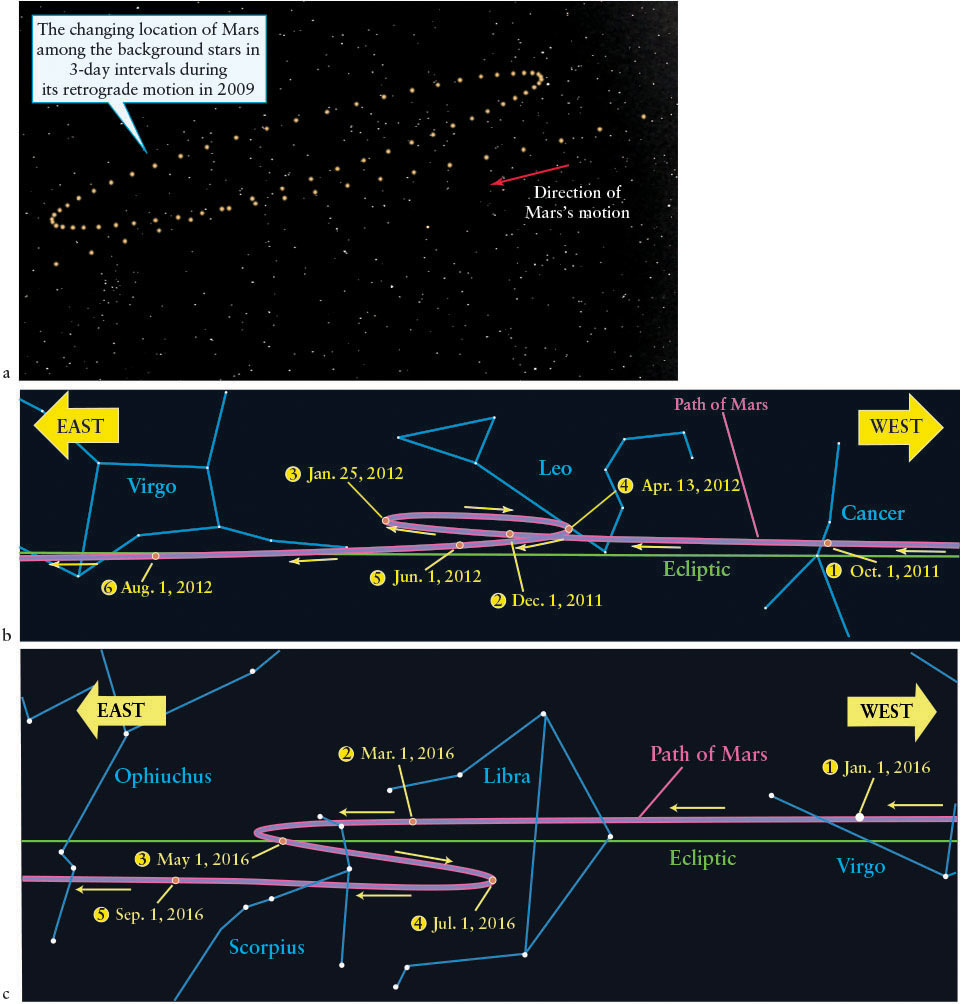
 Paths of Mars (a) The retrograde motion of Mars as it would be seen in a series of images taken on the same photographic plate. (b) To help visualize this motion on the celestial sphere, astronomers often plot the position of Mars (or other body in retrograde motion) on a star chart. The retrograde path is sometimes a loop north, as shown in (a) and (b), or south of the normal path, and sometimes an S-shaped path across the ecliptic. (c) In the middle of 2016, Mars will undergo an S-shaped retrograde motion.
Paths of Mars (a) The retrograde motion of Mars as it would be seen in a series of images taken on the same photographic plate. (b) To help visualize this motion on the celestial sphere, astronomers often plot the position of Mars (or other body in retrograde motion) on a star chart. The retrograde path is sometimes a loop north, as shown in (a) and (b), or south of the normal path, and sometimes an S-shaped path across the ecliptic. (c) In the middle of 2016, Mars will undergo an S-shaped retrograde motion.
46
GUIDED DISCOVERY: Earth-Centered Universe
As we move through the twenty-first century, most of us find it hard to understand why anyone would believe that the Sun, planets, and stars orbit Earth. After all, we know that Earth spins on its axis. We know that the gravitational force from the Sun holds the planets in orbit, just as Earth’s gravitational force holds the Moon in orbit. In childhood these facts become part of our understanding of the motions of the heavenly bodies.
Psychologists call this background information that we use to help explain things a conceptual framework. A conceptual framework contains all of the information we take for granted. For example, when the Sun rises, moves across the sky, and sets, we take for granted that it is Earth’s rotation that causes the Sun’s apparent motion.
Thousands of years ago, philosopher-scientists in many cultures believed that everything was composed of four (or five) elements: earth, water, air, fire (and ether, which, for example, Aristotle assigned as the explanation of why the stars are permanent). These elements were the foundation of their conceptual framework about nature. In a finite universe, as they perceived it, the heavier of these elements, earth and water, descended toward its center, while the lighter ones, air and fire, ascended in it. Earth, composed of earth and water, was therefore at the center. Indeed, it was argued that we lived in the “garbage dump” of the universe, while the other bodies were closer to the outside and, therefore, to heaven. Gravity as a force was unknown and unnecessary, as it was built into the belief system of that time that heavy things “naturally” fell inward. That, for example, was why people, composed of earth and water, were trying to fall toward the center of the universe (implicitly the center of Earth) and were thereby forced down onto Earth’s surface. The Sun, located farther from the center of the universe than is Earth in their belief system, contained fire, so “naturally” it is hot. Philosophers such as Aristotle also perceived the heavenly bodies beyond the Moon as perfect, while Earth and the Moon were considered to be corrupted. Clearly, people thinking about these issues back then had a completely different conceptual framework for understanding the cosmos than we do.
Because they did not feel Earth move under their feet, or see any other indication that Earth is in motion, our forebears sensed nothing to support the belief that we are in orbit around the Sun. The obvious conclusion for one who has a prescientific conceptual framework, even today, is that Earth stays put while objects in the heavens move around it.
This prescientific conceptual framework for understanding the motions of the heavenly bodies was based on the senses and on common sense. That is, people observed motions and drew “obvious,” commonsense conclusions. Today, we incorporate the known and tested laws of physics in our understanding of the natural world. Many of these realities are utterly counterintuitive, and, therefore, the conceptual frameworks that we possess are less consistent with common sense than those held in the past. Studying science helps us develop intuition that is consistent with the actual workings of nature.
Geocentric Explanation of the Planets’ Retrograde Motion
The early Greeks, working in what we now know is an incorrect geocentric (Earth-centered) cosmology, developed many theories to account for the occasional retrograde motion of the planets and the resulting loops that the planets trace out against the background stars. One of the most successful (albeit incorrect) ideas was expounded by the last of the great ancient Greek astronomers, Ptolemy (90–168), who lived in Alexandria, Egypt. His basic concepts are sketched in Figure GD2-1. Each planet is assumed to move in a small circle called an epicycle, the center of which moves in a larger circle called a deferent, whose center is offset from Earth. As viewed from Earth, the epicycle moves eastward along the deferent, and both the epicycle and the planet on it revolve in the same direction (counterclockwise in the figure).
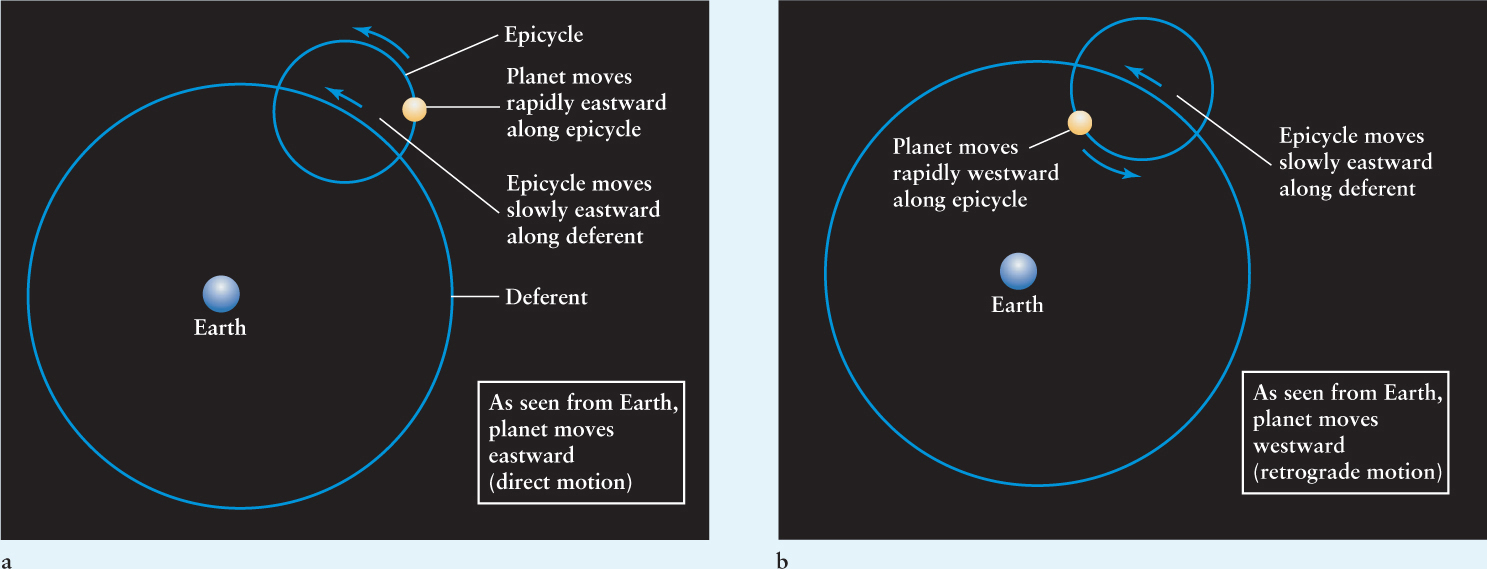
 FIGURE GD2-1 A Geocentric Explanation of Planetary Motion Each planet revolves around an epicycle, which in turn revolves around a deferent centered approximately on Earth. As seen from Earth, the speed of the planet on the epicycle alternately (a) adds to or (b) subtracts from the speed of the epicycle on the deferent, thus producing alternating periods of direct and retrograde motions.
FIGURE GD2-1 A Geocentric Explanation of Planetary Motion Each planet revolves around an epicycle, which in turn revolves around a deferent centered approximately on Earth. As seen from Earth, the speed of the planet on the epicycle alternately (a) adds to or (b) subtracts from the speed of the epicycle on the deferent, thus producing alternating periods of direct and retrograde motions.Most of the time, the motion of the planet on its epicycle adds to the eastward motion of the epicycle on the deferent. Thus, the planet is seen from Earth to be in direct motion (to the left or eastward) against the background stars throughout most of the year (Figure GD2-1a). However, when the planet is on the part of its epicycle nearest Earth, its motion along the epicycle subtracts from the motion of the epicycle along the deferent. The planet thus appears to slow and then halt its usual movement to the left (eastward motion) among the constellations, and then seems to move to the right (westward) among the stars for a few weeks or months (Figure GD2-1b). This concept of epicycles and deferents enabled Greek astronomers to explain the retrograde loops of the planets.
Using the wealth of astronomical data in the Library of Alexandria, including records of planetary positions covering hundreds of years, Ptolemy deduced the sizes of the epicycles and deferents and the rates of revolution needed to produce the recorded paths of the planets. After years of arduous work, he assembled his calculations in the Almagest, in which the positions and paths of the Sun, the Moon, and the planets were described with unprecedented accuracy. In fact, the Almagest was so successful that it became the astronomer’s bible. For more than 1000 years, Ptolemy’s cosmology endured as a useful description of the workings of the heavens.
Eventually, however, the commonsense explanation of the Earth-centered cosmology began to go awry. Errors and inaccuracies that were unnoticeable in Ptolemy’s day compounded and multiplied over the years, especially errors due to precession, the slow change in the direction of Earth’s axis of rotation. Fifteenth-century astronomers made some cosmetic adjustments to the Ptolemaic system. However, the system became less and less satisfactory as more fanciful and arbitrary details were added to keep it consistent with the observed motions of the planets. After Newton’s time, scientists knew that orbital motion required a force to be acting on the body. However, nothing in Ptolemy’s epicycle theory produced such a force.
Margin Question 2-2
Question
Referring to Figure 2-2c, why do you think Mars is seen sometimes above the ecliptic and sometimes below it?
All planetary motions on the celestial sphere are much slower than the apparent daily movement of the entire sky caused by Earth’s rotation. Throughout a single night it is very difficult to detect motion of the planets among the stars. Therefore, the planets always rise with the stars in the eastern half of the sky and set with them in the western half.
The effort to understand planetary motion—and especially to explain retrograde motion—in a geocentric cosmology resulted in an increasingly contrived and complex model (see Guided Discovery: Earth-Centered Universe). The ancient Greek astronomer Aristarchus of Samos (c. 310 b.c.e. – c. 230 b.c.e.) proposed a more straightforward explanation of planetary motion, namely, that all of the planets, including Earth, revolve around the Sun. The retrograde motion of Mars in this heliocentric (Sun-centered) cosmology occurs because the faster-moving Earth overtakes and passes the Red Planet (Figure 2-3). The occasional retrograde movement of a planet is merely the result of our changing viewpoint as we orbit the Sun—an idea that is beautifully simple compared to the geocentric system with all of its complex planetary motions. (The word heliocentric is misleading. Although the local planets, moons, and small pieces of space debris do orbit the Sun, the stars and innumerable other objects in space do not. In fact, the Sun and the bodies that orbit it all orbit the center of our Milky Way Galaxy.)
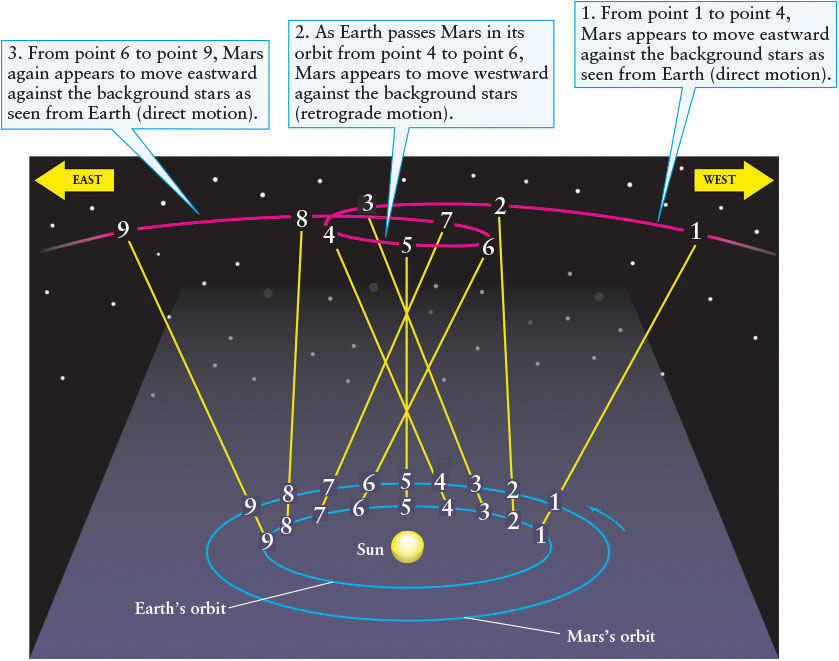
 A Heliocentric Explanation of Retrograde Motion Earth travels around the Sun more rapidly than does Mars. Consequently, as Earth overtakes and passes this slower-moving planet, Mars appears (from points 4 through 6) to move backward among the background stars for a few months.
A Heliocentric Explanation of Retrograde Motion Earth travels around the Sun more rapidly than does Mars. Consequently, as Earth overtakes and passes this slower-moving planet, Mars appears (from points 4 through 6) to move backward among the background stars for a few months.
47
48
2-3 Copernicus devised the first comprehensive heliocentric cosmology
Over the centuries following Aristarchus, increasingly accurate observations of the planets’ locations revealed errors in the predictions of geocentric cosmology. To reconcile that cosmology with the data, more and more complex motions were attributed to the planets. By the mid-1500s, the geocentric cosmology had become truly unwieldy in its efforts to predict the motions of the planets accurately. It was then that the Polish mathematician, lawyer, physician, economist, cleric, and artist Nicolaus Copernicus (1473–1543) resurrected Aristarchus’s theory. Copernicus (see Guided Discovery: Astronomy’s Foundation Builders) was motivated by an effort to simplify the celestial scheme, and eventually his heliocentric cosmology did just that.
The Copernican revolution got off to a rocky start. Copernicus incorrectly assumed that the orbits of Earth and other bodies around the Sun are circular. As a result, the positions his theory predicted were no more accurate than those predicted by the geocentric cosmology.
Pursuing the heliocentric cosmology, Copernicus determined by observations which planets are closer to the Sun than Earth and which are farther away. Because Mercury and Venus are always observed fairly near the Sun, he correctly concluded that their orbits must lie inside Earth’s orbit. The other planets visible to Copernicus—Mars, Jupiter, and Saturn—can sometimes be seen high in the sky in the middle of the night, when the Sun is far below the horizon. This placement can occur only if Earth comes between the Sun and a planet. Copernicus therefore concluded (also correctly) that the orbits of Mars, Jupiter, and Saturn lie outside Earth’s orbit. Today, Mercury and Venus are called inferior planets, while all the planets farther from the Sun than Earth are called superior planets.
The geometric arrangements among Earth, another planet, and the Sun are called configurations. For example, when Mercury or Venus is directly between Earth and the Sun (Figure 2-4), we say the planet is in a configuration called an inferior conjunction; when either of these planets is on the opposite side of the Sun from Earth, its configuration is called a superior conjunction.

49
GUIDED DISCOVERY: Astronomy’s Foundation Builders
In the two centuries between 1500 and 1700, human understanding of the motion of celestial bodies and the nature of the gravitational force that keeps them in orbit surged forward as never before. Theories related to this subject were developed by brilliant thinkers, whose work established and verified the heliocentric model of the solar system and the role of gravity.
Nicolaus Copernicus (1473–1543)
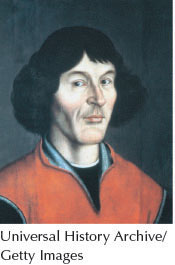
Copernicus, the youngest of four children, was born in Torun, Poland. He pursued his higher education in Italy, where he received a doctorate in canon law and studied medicine. Copernicus developed a heliocentric theory of the known universe and just before his death in 1543 published this work under the title De revolutionibus orbium coelestium. His revolutionary theory was flawed in that he assumed that the planets had circular orbits around the Sun. This was corrected by Johannes Kepler.
Tycho Brahe (1546–1601) and Johannes Kepler (1571–1630)

Tycho (depicted to the right and within the portrait of Kepler below) was born to nobility in the Danish city of Knudstrup, which is now part of Sweden. At age 20, he lost part of his nose in a duel and wore a metal replacement thereafter. In 1576, the Danish king Frederick II built Tycho an astronomical observatory that Tycho named Uraniborg (after Urania, Greek muse of astronomy). Tycho rejected both Copernicus’s heliocentric theory and the Ptolemaic geocentric system. He devised a halfway theory called the Tychonic system. According to Tycho’s theory, Earth is stationary, with the Sun and the Moon revolving around it, while all the other planets revolve around the Sun.
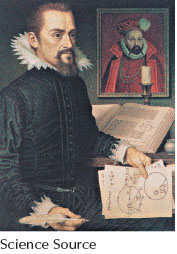
Kepler was educated in Germany, where he spent 3 years studying mathematics, philosophy, and theology. In 1596, he published a booklet in which he attempted to mathematically predict the planetary orbits. Although his theory was altogether wrong, its boldness and originality attracted the attention of Tycho Brahe, whose staff Kepler joined in 1600. After Tycho’s death, Kepler deduced his three laws based on Tycho’s observations.
Galileo Galilei (1564–1642)

Born in Pisa, Italy, Galileo studied medicine and philosophy at the University of Pisa. He abandoned medicine in favor of mathematics. He held the chair of mathematics at the University of Padua and eventually returned to the University of Pisa as a professor of mathematics. There, Galileo formulated his famous law of falling bodies: All objects fall with the same acceleration regardless of their weight. In 1609, he constructed a telescope and made a host of discoveries that contradicted the teachings of Aristotle and the Roman Catholic Church. He summed up his life’s work on motion, acceleration, and gravity in the book Dialogues Concerning the Two Chief World Systems, published in 1632.
Isaac Newton (1642–1727)

Newton delighted in constructing mechanical devices, such as sundials, model windmills, a water clock, and a mechanical carriage. He received a bachelor’s degree in 1665 from the University of Cambridge. While there, he began developing the mathematics that later became calculus (developed independently by the German philosopher and mathematician Gottfried Leibniz, 1646–1716). While pursuing experiments in optics, Newton constructed a reflecting telescope and also discovered that white light is actually a mixture of all colors. His major work on forces and gravitation was the tome Philosophiae Naturalis Principia Mathematica, which appeared in 1687. In 1704, Newton published his second great treatise, Opticks, in which he described his experiments and theories about light and color. Upon his death in 1727, Newton was buried in Westminster Abbey, the first scientist to be so honored.
50
The angle between the Sun and a planet as viewed from Earth is called the planet’s elongation. A planet’s elongation varies from zero degrees to a maximum value, depending upon where we see it in its orbit around the Sun. At greatest eastern or greatest western elongation, Mercury and Venus are as far from the Sun in angle as they can be. This position is about 28° for Mercury and about 47° for Venus. The superior planets all have maximum elongations of 180o.
When either Mercury or Venus rises before the Sun, the planet is visible in the eastern sky as a bright “star” and is often called the “morning star.” Similarly, when either of these two planets sets after the Sun, the planet is visible in the western sky and is then called the “evening star.” Because these two planets are not always at their greatest elongations, they are often very close in angle to the Sun. This positioning is especially true of Mercury, often making it hard to see from Earth. Venus is often nearly halfway up the sky at sunrise or sunset and therefore quite noticeable during much of its orbit. Because they are so bright and sometimes appear to change color due to the motion of Earth’s atmosphere, Venus and Mercury are often mistaken for UFOs. (The same motion of the air causes the road in front of your car to shimmer on a hot day.)
Planets farther from the Sun than Earth have different configurations. When one of these planets is located behind the Sun, as seen from Earth, that planet is said to be in conjunction. When a planet is opposite the Sun in the sky, that planet is at opposition. It is not difficult to determine when a planet happens to be located at one of the key positions in Figure 2-4. For example, when Mars is at opposition, it appears high and bright in the sky at midnight.
It is relatively easy to follow a planet as it moves from one configuration to another. However, these observations alone do not tell us the planet’s actual orbit, because Earth, from which we make the observations, is also moving. Copernicus was therefore careful to distinguish between two characteristic time intervals, or periods, of each planet.
Recall from your study of the Moon in Chapter 1 that a planet’s sidereal period is the time it takes that body to make one complete orbit of the Sun as measured with respect to the distant stars; an observer fixed at the Sun’s location watching that planet would see it start at one point on the celestial sphere, go around the sphere, and end at same place it started from. The sidereal period or orbit is the length of a year for each planet.
The other useful time interval that Copernicus used is the synodic period. The synodic period is the time that elapses between two successive identical configurations as seen from Earth. This period can be from one opposition to the next, for example, or from one conjunction to the next (of the same type, Figure 2-5). The synodic period tells us, among other things, when to expect a planet to be closest to Earth and, therefore, most easily studied.
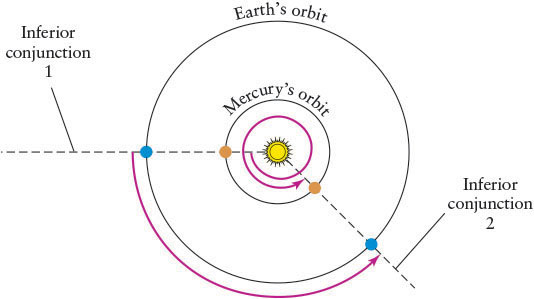
51
Insight Into Science: Take a Fresh Look
When a scientific concept is hard to visualize, try another perspective. For example, a planet’s sidereal period of orbit is easy to understand when viewed from the Sun but more complicated as seen from Earth. The synodic period of each planet, on the other hand, is easily determined from Earth. As we will see, especially when we study Einstein’s theories of relativity, each of these perspectives is called a frame of reference.
Thus, nearly 500 years ago, Copernicus was able to obtain the first six entries shown in Table 2-1 (the others are contemporary results included for completeness). Copernicus was then able to devise a straightforward geometric method for determining the distances of the planets from the Sun. His answers turned out to be remarkably close to the modern values, as shown in Table 2-2. From these two tables it is apparent that the farther a planet is from the Sun, the longer it takes to complete its orbit.
| Synodic (year) | Sidereal (year) | |
|---|---|---|
| Mercury | 0.318 | 0.241 |
| Venus | 1.599 | 0.616 |
| Earth | — | 1.0 |
| Mars | 2.136 | 1.9 |
| Jupiter | 1.092 | 11.9 |
| Saturn | 1.035 | 29.5 |
| Uranus | 1.013 | 84.0 |
| Neptune | 1.008 | 164.8 |
| Measurement (AU) | ||
|---|---|---|
| By Copernicus | Modern | |
| Mercury | 0.38 | 0.39 |
| Venus | 0.72 | 0.72 |
| Earth | 1.00 | 1.00 |
| Mars | 1.52 | 1.52 |
| Jupiter | 5.22 | 5.20 |
| Saturn | 9.07 | 9.54 |
| Uranus | Unknown | 19.19 |
| Neptune | Unknown | 30.06 |
Copernicus presented his heliocentric cosmology, including supporting observations and calculations, in a book entitled De revolutionibus orbium coelestium (On the Revolutions of the Celestial Spheres), which was published in 1543, the year of his death. While his theory was complex because of the flawed assumption of circular orbits, it did explain some things more simply than the geocentric cosmology, most notably retrograde motion. It took another 76 years before the Copernican revolution achieved its full potential. Between 1609 and 1619, Johannes Kepler, using data accumulated by Danish astronomer Tycho Brahe, corrected Copernicus’s incorrect assumption of circular orbits and presented his three laws of planetary orbits, which we will now explore.
2-4 Tycho Brahe made astronomical observations that disproved ancient ideas about the heavens
Margin Question 2-3
Question
Why do I say “of the same type” in reference to Figure 2-5?
In November 1572, a bright star suddenly appeared in the constellation Cassiopeia. At first, it was even brighter than Venus, but then it began to grow dim. After 18 months the star faded from view.
Modern astronomers recognize this event as a supernova explosion, the violent death of a certain type of star (see Chapter 13). In the sixteenth century, however, the prevailing opinion was quite different. Teachings dating back to Aristotle and Plato argued that the heavens were permanent and unalterable. From that perspective, the “new star” of 1572 could not really be a star at all, because the heavens do not change. Many astronomers and theologians of the day argued that the sighting must be some sort of bright object quite near Earth, perhaps not much farther away than the clouds overhead. A 25-year-old Danish astronomer named Tycho Brahe (1546–1601; see Guided Discovery: Astronomy’s Foundation Builders) realized that straightforward observations might reveal the distance to this object.
Consider what happens when two people look at a nearby object from different places—they see it in different positions relative to the things behind it. Furthermore, their heads face at different angles when looking at it. This variation in angle that occurs when viewing a nearby object from different locations is called parallax (Figure 2-6).

Tycho reasoned as follows: If the new star is nearby, its position should shift against the background stars over the course of a night (Figure 2-7a). His careful observations, done in the spirit of the scientific method, failed to disclose any parallax, and so the new star had to be far away, farther from Earth than anyone had imagined (Figure 2-7b). Tycho summarized his findings in a small book, De nova stella (On the New Star), published in 1573.
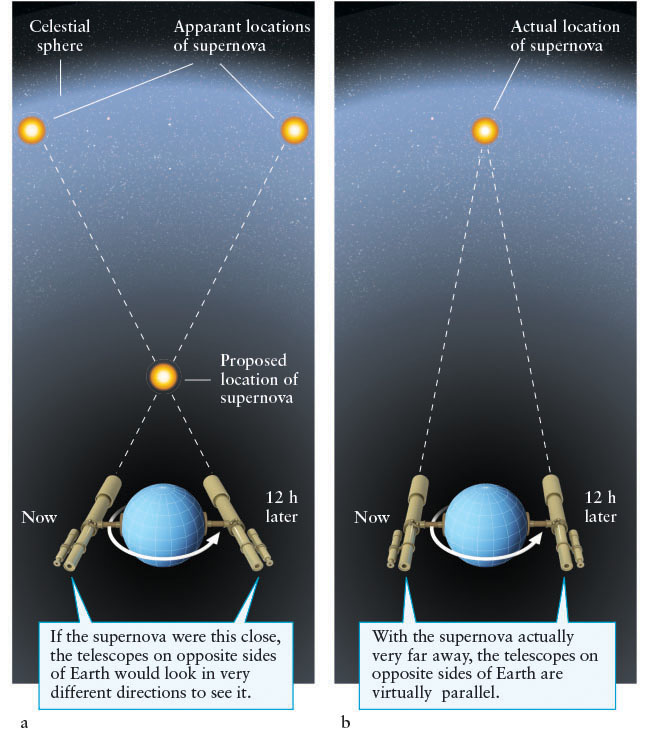
Margin Question 2-4
Question
Describe a simple experiment to demonstrate that your eyes (and, implicitly, your brain) use parallax to determine distances.
52
Tycho’s astronomical records were soon to play an important role in the development of a heliocentric cosmology. From 1576 to 1597, he made comprehensive observations, measuring planetary positions with an accuracy of 1 arcminute, about as precise as is possible with nontelescopic instruments (the telescope was invented in 1608). Arcminute (arcmin) is defined in An Astronomer’s Toolbox 1-1: Observational Measurements Using Angles. Upon Tycho’s death in 1601, most of these invaluable records were given to his gifted assistant, Johannes Kepler (1571–1630; see Guided Discovery: Astronomy’s Foundation Builders).